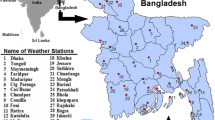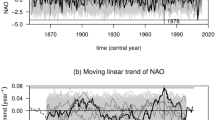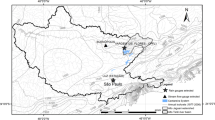Abstract
The objective of the current study is to present a comparison of techniques for the forecasting of low-frequency climate oscillation indices with a focus on the Great Lakes system. A number of time series models have been tested including the traditional autoregressive moving average (ARMA) model, dynamic linear model (DLM), generalized autoregressive conditional heteroskedasticity (GARCH) model, as well as the nonstationary oscillation resampling (NSOR) technique. These models were used to forecast the monthly El Niño-Southern Oscillation (ENSO) and Pacific Decadal Oscillation (PDO) indices which show the most significant teleconnection with the net basin supply (NBS) of the Great Lakes system from a preliminary study. The overall objective is to predict future water levels, ice extent, and temperature, for planning and decision making purposes. The results showed that the DLM and GARCH models are superior for forecasting the monthly ENSO index, while the forecasted values from the traditional ARMA model presented a good agreement with the observed values within a short lead time ahead for the monthly PDO index.










Similar content being viewed by others
Data availability
The climate indices data used in the current study is already available to public. The website is mentioned in the manuscript.
Code availability
Code is available upon request to the corresponding author.
Abbreviations
- t :
-
Time index
- X t :
-
Time-dependent variable
- X t :
-
Vector of multivariate time-dependent variables
- Z t :
-
Time-independent white noise variable or its square is time dependent in the representation of GARCH model
- p, q :
-
Mode order of ARMA model
- \(\theta\),\(\varphi\) :
-
Parameters of ARMA model
- n, n par :
-
Number of observations and parameters, respectively
- h :
-
Prediction lead time
- \({\widehat{X}}_{n}(h)\) :
-
h-Step ahead forecast, Xn+h
- L(.):
-
Likelihood
- B :
-
Backward shift operator
- \(\mu\),\({\sigma }^{2}\) :
-
Mean and variance
- C:
-
Covariance matrix
- \(\psi\) :
-
Parameter set of a model
- \(\alpha ,\beta\) :
-
Parameters of GARCH model
- \({\Lambda }_{t}\) :
-
M-dimensional state vector
- \({V}_{t},{W}_{t}\) :
-
Mutually independent error sequences with normal distribution
- \({F}_{t},{G}_{t}\) :
-
Parameter and evolution matrices in DLM
References
Abraham B, Ledolter J (2009) Statistical Methods for Forecasting. Wiley, New York
Ahn JH, Kim HS (2005) Nonlinear modeling of El Nino/southern oscillation index. J Hydrol Eng 10:8–15
Akaike H (1974) A new look at the statistical model identification. IEEE Trans Autom Control 19(6):716–723
Alexander MA, Blade I, Newman M, Lanzante JR, Lau NC, Scott JD (2002) The atmospheric bridge: the influence of ENSO teleconnections on air-sea interaction over the global oceans. J Clim 15:2205–2231
Andersen TG, Bollerslev T, Diebold FX, Labys P (2003) Modeling and forecasting realized volatility. Econometrica 71:579–625
Bollerslev T (1986) Generalized autoregressive conditional heteroskedasticity. Journal of Econometrics 31:307–327
Bollerslev T, Chou RY, Kroner KF (1992) ARCH modeling in finance. A review of the theory and empirical evidence. J Econ 52:5–59
Bosley TM, Alorainy IA, Salih MA, Aldhalaan HM, Abu-Amero KK, Oystreck DT, Tischfield MA, Engle EC, Erickson RP (2008) The clinical spectrum of homozygous HOXA1 mutations. Am J Med Genet A 146A:1235–1240
Brockwell PJ, Davis R (1988) Simple consistent estimation of the coeffcients of a linear filter. Stoch Process Appl 28:47–59
Brockwell PJ, Davis RA (2003) Introduction to Time Series and Forecasting. Springer, Harrisonburg, VA
Burg J (1978) A new analysis technique for time series data. John Wiley & Sons Inc, New York
Chen D, Cane MA, Kaplan A, Zebiak SE, Huang DJ (2004) Predictability of El Nino over the past 148 years. Nature 428:733–736
Cheng YJ, Tang YM, Jackson P, Chen DK, Zhou XB, Deng ZW (2010) Further analysis of singular vector and ENSO predictability in the Lamont model-Part II: singular value and predictability. Clim Dyn 35:827–840
Cheng YJ, Tang YM, Zhou XB, Jackson P, Chen DK (2010b) Further analysis of singular vector and ENSO predictability in the Lamont model-Part I: singular vector and the control factors. Clim Dyn 35:807–826
Elek P, Márkus L (2004) A long range dependent model with nonlinear innovations for simulating daily river flows. Nat Hazards and Earth Syst Sci 4:277–283
Engle R (2001) GARCH 101: The use of ARCH/GARCH models in applied econometrics. J Econ Perspect 15:157–168
Engle R (2002) New frontiers for arch models. J Appl Economet 17:425–446
Engle RF (1982) Autoregressive conditional heteroscedasticity with estimates of the variance of United Kingdom inflation. Econometrica 50:987–1007
Engle RF, Kroner KF (1995) Multivariate simultaneous generalized arch. Economet Theor 11:122–150
Fan J, Yao Q (2003) Nonlinear Time Series - Nonparametric and Parametric Methods. Springer, New York
Francq C, Zakoian J-M (2010) GARCH Models: Structure, Statistical Inference and Financial Applications. Wiley, Chippenham, United Kingdom
Godolphin E, Harrison P (1975) Equivalence theorems for polynomial projecting predictors. J Royal Stat Soc Series B-Stat Methodol B 35:205–215
Hannan EJ, Rissanen J (1982) Recursive estimation of mixed autoregressive-moving average order. Biometrika 69:81–94
Huang NE, Shen Z, Long SR, Wu MLC, Shih HH, Zheng QN, Yen NC, Tung CC, Liu HH (1998) The empirical mode decomposition and the Hilbert spectrum for nonlinear and non-stationary time series analysis. Proc Royal Soc London Ser a-Math Phys Eng Sci 454:903–995
Huang NE, Wu ZH (2008) A review on Hilbert-Huang transform: method and its applications to geophysical studies. Rev Geophys 46:RG2006
Hurvich CM, Tsai CL (1989) Regression and time series model selection in small samples. Biometrika 76(2):297–307
Immerzeel WW, Bierkens MFP (2010) Seasonal prediction of monsoon rainfall in three Asian river basins: the importance of snow cover on the Tibetan Plateau. Int J Climatol 30:1835–1842
Künsch HR (2001) State space and hidden Markov models. In: Complex Stochastic Systems. Chapman and Hall/CRC, Boca Raton, pp 109–173
Kalman RE (1960) A new approach to linear filtering and prediction problems. Trans ASME-J Basic Eng 82:35–45
Kirtman BP, Min D (2009) Multimodel ensemble ENSO prediction with CCSM and CFS. Mon Weather Rev 137:2908–2930
Lall U, Sharma A (1996) A nearest neighbor bootstrap for resampling hydrologic time series. Water Resour Res 32:679–693
Lee T, Ouarda TBMJ (2010a) Long-term prediction of precipitation and hydrologic extremes with nonstationary oscillation processes. J Geophys Res-Atmos 115. https://doi.org/10.1029/2009JD012801
Lee T, Ouarda TBMJ (2010b) Multivariate Stochastic Simulation of Climate Indices with Empirical Mode Decomposition. Quebec, INRS-ETE, pp 1–78
Lee T, Ouarda TBMJ (2011) Identification of model order and number of neighbors for k-nearest neighbor resampling. J Hydrol 404:136–145
Lee T, Ouarda TBMJ (2011b) Prediction of climate nonstationary oscillation processes with empirical mode decomposition. J Geophys Res Atmos 116
Lee T, Ouarda TBMJ (2012) Stochastic simulation of nonstationary oscillation hydroclimatic processes using empirical mode decomposition. Water Res Res 48
Lee T (2008) Stochastic simulation of hydrologic data based on nonparametric approaches, Ph. D. Dissertation. Civil and Environmental Engineering. Colorado State University, Fort Collins, Ph. D.: 346
Mantua NJ, Hare SR, Zhang Y, Wallace JM, Francis RC (1997) A Pacific interdecadal climate oscillation with impacts on salmon production. Bull Am Meteor Soc 78:1069–1079
Migon H et al (2005) Bayesian dynamic models. In: Day D, Rao C (eds) Handbook of Statistics. Elsevier, New York, pp 553–588
Modarres R, Ouarda TBMJ (2013) Generalized autoregressive conditional heteroscedasticity modelling of hydrologic time series. Hydrol Process 27:3174–3191
Modarres R, Ouarda TBMJ (2013) Modeling rainfall-runoff relationship using multivariate GARCH model. J Hydrol 499:1–18
Modarres R, Ouarda TBMJ (2014) A generalized conditional heteroscedastic model for temperature downscaling. Clim Dyn 43:2629–2649
Nairn-Birch N, Diez D, Eslami E, Fauria MM, Johnson EA, Schoenberg FP (2009) Simulation and estimation of probabilities of phases of the Pacific Decadal Oscillation. Environmetrics 22:79–85
Naizghi MS, Ouarda TBMJ (2017) Teleconnections and analysis of long-term wind speed variability in the UAE. Int J Climatol 37:230–248
Niranjan Kumar K, Ouarda TBMJ, Sandeep S, Ajayamohan RS (2016) Wintertime precipitation variability over the Arabian Peninsula and its relationship with ENSO in the CAM4 simulations. Clim Dyn 47:2443–2454
Ouachani R, Bargaoui Z, Ouarda T (2013) Power of teleconnection patterns on precipitation and streamflow variability of upper Medjerda Basin. Int J Climatol 33:58–76
Petris G, Petrone S, Campagnoli P (2009) Dynamic Linear Models with R. Springer, New York
Rodionov S, Assel RA (2003) Winter severity in the Great Lakes region: a tale of two oscillations. Climate Res 24:19–31
Salas JD, Delleur JW, Yevjevich V, Lane WL (1980) Applied Modeling of Hydrologic Time Series. Water Resources Publications, Littleton, Colorado
Schneider EK, Huang B, Zhu Z, Dewitt DG, Kinter Iii JL, Kirtman BP, Shukla J (1999) Ocean data assimilation, initialization, and predictions of ENSO with a coupled GCM. Mon Weather Rev 127:1187–1207
Snyder RD (1985) Recursive estimation of Dynamic Linear Models, Journal of the Royal Statistical Society. Series B (methodological) 47:272–276
Thomas BE (2007) Climatic fluctuations and forecasting of streamflow in the lower Colorado River Basin. J Am Water Resour Assoc 43:1550–1569
Trenberth KE (1997) The definition of El Nino. Bull Am Meteor Soc 78:2771–2777
Tsonis AA, Elsner JB, Sun D-Z (2007) The Role of El Niño—Southern Oscillation in Regulating its Background State, Nonlinear Dynamics in Geosciences. Springer New York, pp 537–555
Walker GT (1932) On periodicity in series of related terms. Proc Royal Soci A 131:518–532
Wang W, Van Gelder PHAJM, Vrijling JK, Ma J (2005) Testing and modelling autoregressive conditional heteroskedasticity of streamflow processes. Nonlinear Process Geophys 12:55–66
West M, Harrison J (1997) Bayesian Forecasting and Dynamic Models. Springer, New York
Westra S, Sharma A (2010) An upper limit to seasonal rainfall predictability? J Clim 23:3332–3351
Wilks DS (1997) Resampling hypothesis tests for autocorrelated fields. J Clim 10:65–82
Wolter K, Timlin MS (1993) Monitoring ENSO in COADS with a seasonally adjusted principal component index, Proc. of the 17th Climate Diagnostics Workshop. NOAA/NMC/CAC, NSSL, Oklahoma Clim. Survey, CIMMS and the School of Meteor., Univ. of Oklahoma, Norman, OK, pp 52–57
Wu R, Kirtman BP (2003) On the impacts of the Indian summer monsoon on ENSO in a coupled GCM. Q J R Meteorol Soc 129:3439–3468
Wu ZH, Huang NE (2004) A study of the characteristics of white noise using the empirical mode decomposition method. Proc Royal Soc London Series a-Math Phys Eng Sci 460:1597–1611
Yule GU (1927) On a method of investigating periodicities in disturbed series, with special reference to Wolfer’s sunspot numbers. Philoso Trans Royal Soc London Series A 226:267–298
Zhang Y, Wallace JM, Battisti DS (1997) ENSO-like interdecadal variability: 1900–93. J Clim 10:1004–1020
Funding
This work was supported by the National Research Foundation of Korea (NRF) grant funded by the Korean Government (MEST) (2023R1A2C1003850).The first author acknowledges that this research was partially supported by a grant (2022-MOIS63-001) of Cooperative Research Method and Safety Management Technology in National Disaster funded by Ministry of Interior and Safety (MOIS, Korea).
Author information
Authors and Affiliations
Contributions
TS carried out selecting methods and programmed the models used as well as drafted the manuscript. TO supervised the study and edited the manuscript.
Corresponding author
Ethics declarations
Conflict of interest
The authors declare no competing interests.
Additional information
Publisher's note
Springer Nature remains neutral with regard to jurisdictional claims in published maps and institutional affiliations.
Note that the current manuscript has been produced by the International Joint Commission (IJC) for the management of the great lakes. The manuscript has never submitted it for publication in a journal.
Supplementary Information
Below is the link to the electronic supplementary material.
Rights and permissions
Springer Nature or its licensor (e.g. a society or other partner) holds exclusive rights to this article under a publishing agreement with the author(s) or other rightsholder(s); author self-archiving of the accepted manuscript version of this article is solely governed by the terms of such publishing agreement and applicable law.
About this article
Cite this article
Lee, T., Ouarda, T.B.M.J. & Seidou, O. Characterizing and forecasting climate indices using time series models. Theor Appl Climatol 152, 455–471 (2023). https://doi.org/10.1007/s00704-023-04434-z
Received:
Accepted:
Published:
Issue Date:
DOI: https://doi.org/10.1007/s00704-023-04434-z




